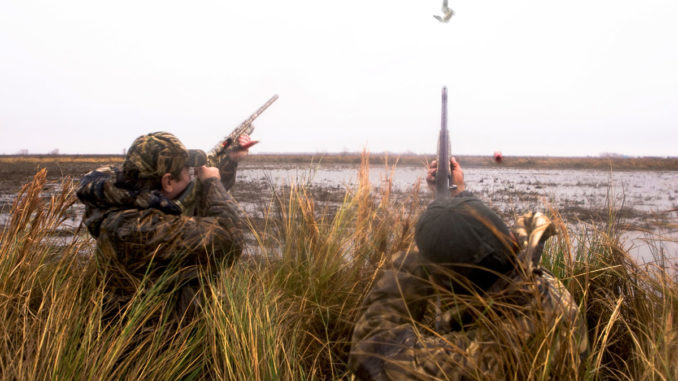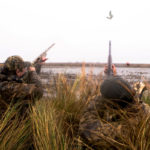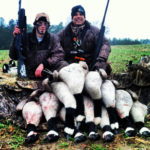
Layout blinds set up in fields and along river banks can be very productive when it comes to calling in Canada geese during the late season
The harvested corn field looked dull and brown against the gray, early morning December sky. Small shapes resembling Canada geese dotted the center of the field, and a handful of coffin-shaped structures barely showed above the stubble of cut corn stalks, seemingly breathing fog into the cold, damp air.
In the distance, a flock of geese looking for a friendly spot to feed broke the silence. “Onk, onk! Onk, onk!,” they called. Something — or someone — in the corn field answered with a series of calls, and what appeared to be a too-far-away-to-care formation of Canadas veered toward the field, spotted the familiar-looking shapes and colors of their brethren and prepared for touchdown.
This part looks like slow motion, as the geese honk and slowly make their way across the sky. But this is when goose hunters — especially those in layout blinds in the middle of the decoys the live geese are looking at — must show restraint and patience. They watch through mesh doors, picking out their goose, knowing the action is about to start.
With feet and wings in the landing position, the coffin shapes come to life, spring open, and unleash a volley of 3 1/2-inch Winchester loads of No. 2 shot that drop a handful of geese to the ground, and send another eight or so skyward, wanting nothing more than to get away from this place that looked so promising just seconds earlier.
Those coffin shapes were layout blinds filled with hunters, and it was Lancaster’s Blake Hodge of Wrecking Crew Guide Service who called in the geese in a scene that would be repeated several more times during the morning’s hunt and is typical of a December goose hunt in Lancaster County with Hodge and his dad, Daryl, who operate the Wrecking Crew.
It sounds easy, but it’s not as simple as putting some decoys in a field, laying down with shotguns and waiting.
“The No. 1 most-important factor this time of year is scouting,” Daryl Hodge said. “You’ve got to know what’s around in your area and where they are going. This time of year, new geese are coming in from up north every week, so you’ve got to know where these geese are visiting,” he said.
If you’re lucky, they will be visiting areas that you can access, otherwise, you’re going to have to attract them to the areas you can hut. That makes things a bit more challenging, but with a spread of decoys and some decent calling, these geese will cooperate.
“They are trusting the local Canada population, so when they see geese feeding, they’ll feed in those same areas,” said Hodge. And while they may shy away from landing directly in the same section of a field where other geese are feeding, Hodge said calling with a feeding murmur can bring them right to your decoys.
Scouting also reveals habits of the local goose population, and Hodge said hunters should mimic those geese when setting up their spread of decoys.
“I like to use four dozen to six dozen decoys together, but if the trend among the local geese is to gather in smaller groups, I will trim it down,” he said.
Excellent — not just good — camouflage is another important element of success. This includes face paint or at least a face mask.
“Everybody wants to look up, and nothing will give a group of hunters away faster than a naked face looking skyward,” said Hodge, who prefers his hunters wear black skull caps and t-shirts, rather than traditional camo patterns. “Especially if we are moving around at all while any geese are passing over or near us, they will see those small black shapes moving and will think it is other geese walking around. This is better than just being camouflaged in the traditional sense.”
Ideally, nobody is moving around when the geese are flying. Instead, they are lying on their backs in layout blinds, peeking through the mesh windows of the doors, guns at the ready. Calling starts off when the geese are sighted, if not before. A simple “cluck” will usually get them interested enough to come around for a closer look, and Hodge prefers a “double-cluck” call. Once the airborne geese show their intentions to land, Hodge said a feeding murmur will usually lure them into the decoys. Without the feeding murmur, they will often land in the same field but give the decoys their space, which is obviously not in the best interest of the hunters.
Hodge likes to hunt harvested corn fields, because the stubble of stalks stand up high enough to hide the layout blinds.
“But sometimes the geese are more active in the planted wheat fields, which are usually only two to three inches tall by mid-November,” said Hodge, who aids in the concealment of hunters by finding dead plants or branches along the edges of the field, and adding them to his layout blinds. “I much prefer local materials to commercial camouflage in these cases.”
Fields aren’t the only spots to hunt geese this time of year. Hodge likes hunting them on the Catawba and Wateree rivers. Hodge likes to use a boat as a means of transportation, but not as a shooting platform. Islands and sandbars are prime hunting spots in the rivers, and Hodge said keeping the boat hidden is crucial here.
“Two things that geese are looking for are food and water, so plenty will come into these rivers, especially geese that are just arriving for the first time,” said Hodge, who likes to blend in with the natural surroundings as much as possible, picking up materials he can find along the river’s edge. Wax myrtle branches are always a good bet because they are plentiful along both rivers, and just a few branches go a long way toward concealing a shooting position.
Whether hunting in the fields or on water, Hodge prefers 12-gauge shotguns, but said 20-gauges will do the job, and are especially popular among youth and female hunters.
“In the fields, when they are decoying real well, you can kill them with a .410, but I prefer sticking with the 12-gauge for most situations,” said Hodge, who prefers shooting 3 1/2-inch Winchester Blind Side shells with extra knockdown power for these tough birds.
“I tell my clients to aim for the head. That is the best place for the quickest and cleanest kill on a goose. Their feathers and chests are tough, so shot placement is important,” Hodge said.






Be the first to comment